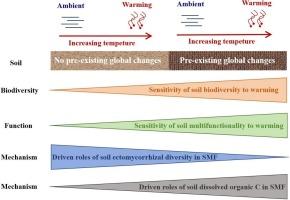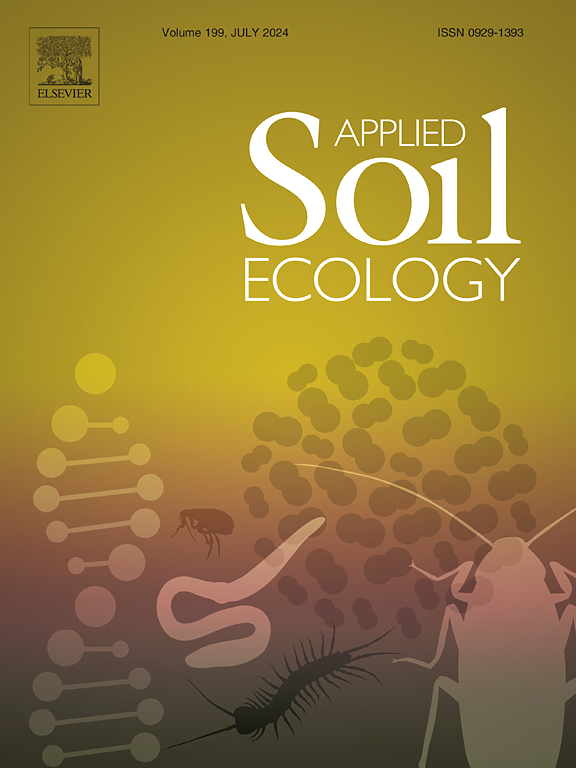Pre-existing global change legacies regulate the responses of multifunctionality to warming
IF 4.8
2区 农林科学
Q1 SOIL SCIENCE
引用次数: 0
Abstract
Soil biodiversity and function are critical for supporting life and providing essential services for human beings on Earth. We know that soils are highly vulnerable to warming in terrestrial ecosystems. However, it remains unclear whether the legacies of pre-existing global changes can exacerbate the responses of soil biodiversity and function to warming. To address this knowledge gap, we conducted a four-month growth chamber experiment to investigate the responses of soil biodiversity - focusing on three fungal functional groups (soil pathogen, saprotroph and ectomycorrhizal richness) and soil multifunctionality (measured by seven enzyme activities associated with C, N, P, and S cycling) to simulated warming. The soils were collected from four groups of global change located within the same experimental station in Australia, which were subjected to multiple global change factors, including CO2 enrichment, altered precipitation patterns, irrigation and fertilization, and nutrient addition. In general, soil biodiversity and multifunctionality in soils previously subjected to global changes were more susceptible to warming than those in control soils (i.e., without pre-existing global changes). Different biotic and abiotic factors drove multifunctionality under ambient and warming conditions. Specifically, soil ectomycorrhizal diversity, primarily driven by soil pH, had a more significant positive influence on soil multifunctionality than soil properties under ambient conditions. These findings suggest that environmental filtering may also regulate the biodiversity of fungal functional groups and functions in soils subjected to pre-existing global changes. While under warming conditions, soil dissolved organic C was more important than soil biodiversity (i.e., saprotroph richness) in affecting soil multifunctionality. Our results demonstrate that the legacies of global changes may weaken the positive effects of soil biodiversity and its interactions with soil physicochemical properties in regulating soil functions in response to warming. Taken together, our work indicates that pre-existing global change legacies regulate the responses of multifunctionality to warming, with implication for understanding how climate change and soil legacies influence soil conservation in a warmer world.

先前存在的全球变化遗留问题调节着多功能性对气候变暖的反应
土壤的生物多样性和功能对于支持地球上的生命和为人类提供基本服务至关重要。我们知道,在陆地生态系统中,土壤极易受到气候变暖的影响。然而,目前仍不清楚先前存在的全球变化是否会加剧土壤生物多样性和功能对气候变暖的反应。为了填补这一知识空白,我们进行了一项为期四个月的生长室实验,以研究土壤生物多样性对模拟气候变暖的反应--重点是三个真菌功能群(土壤病原体、噬菌体和外生菌根丰富度)和土壤多功能性(通过与碳、氮、磷和硒循环相关的七种酶活性来测量)。土壤采集自位于澳大利亚同一实验站内的四个全球变化组,这些组受到多种全球变化因素的影响,包括二氧化碳富集、降水模式改变、灌溉和施肥以及养分添加。总体而言,与对照土壤(即未发生过全球变化的土壤)相比,曾受到全球变化影响的土壤的生物多样性和多功能性更容易受到气候变暖的影响。在环境条件和气候变暖条件下,不同的生物和非生物因素驱动着多功能性。具体来说,在环境条件下,土壤外生菌根多样性对土壤多功能性的积极影响比土壤特性更显著,而土壤特性主要受土壤酸碱度的影响。这些研究结果表明,环境过滤也可能会调节土壤中真菌功能群和功能的生物多样性。而在气候变暖条件下,土壤溶解有机碳对土壤多功能性的影响比土壤生物多样性(即植食性真菌丰富度)更重要。我们的研究结果表明,全球变化的后遗症可能会削弱土壤生物多样性及其与土壤理化性质的相互作用在应对气候变暖时调节土壤功能的积极作用。综上所述,我们的研究表明,先前存在的全球变化遗留问题会调节土壤多功能性对气候变暖的反应,这对理解气候变化和土壤遗留问题如何影响气候变暖世界的土壤保护具有重要意义。
本文章由计算机程序翻译,如有差异,请以英文原文为准。
求助全文
约1分钟内获得全文
求助全文
来源期刊

Applied Soil Ecology
农林科学-土壤科学
CiteScore
9.70
自引率
4.20%
发文量
363
审稿时长
5.3 months
期刊介绍:
Applied Soil Ecology addresses the role of soil organisms and their interactions in relation to: sustainability and productivity, nutrient cycling and other soil processes, the maintenance of soil functions, the impact of human activities on soil ecosystems and bio(techno)logical control of soil-inhabiting pests, diseases and weeds.
 求助内容:
求助内容: 应助结果提醒方式:
应助结果提醒方式:


